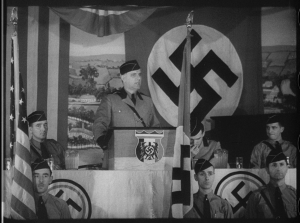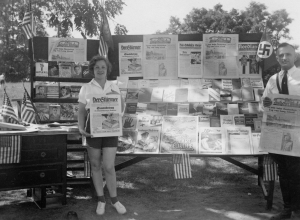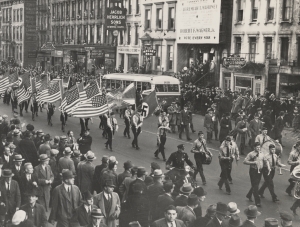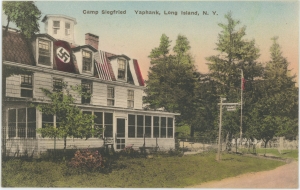 “It looked like any summer camp in America. It looked normal. But it wasn’t normal. It was Nazi camp.”
“It looked like any summer camp in America. It looked normal. But it wasn’t normal. It was Nazi camp.”
If you’ve ever gone to summer camp as a kid, you probably joined your Girl or Boy Scout pals… or devout parishioners from your place of worship… or fellow musical theater wannabes itching to put on a show under a blanket of stars. During the 1930s, a growing number of American parents chose another path for their kids. Nazi camp.
Democracy lost its luster during the Great Depression, stoking support on our shores for European fascism and Nazism. Rabid isolationists, Nazi sympathizers, anti-Semites and racists filled our hallowed halls of government (Asst. Secretary of State Breckinridge Long) and churches (Rev. Charles E. Coughlin). They made history in the air (Charles Lindbergh) and on land (Henry Ford). They encouraged Americans to fear and denigrate immigrants (especially Jews) as dirty, dumb and diseased…hardly assets to be welcomed into America’s white, Anglo Saxon neighborhoods. Membership in extremist organizations, like the Ku Klux Klan and the German American Bund, surged across the country.
The German American Bund, under the guise of patriotism, grew their roster with rallies, meetings and camps for kids centered on Nazi ideology. Unbelievably, the Bund’s followers carried swastika-emblazoned flags and snapped up their arms in Nazi salute. Its backstory is deftly told in Nazi Town, USA debuting on the PBS American Experience series tonight, Tuesday, January 23, 2024, 9:00 – 10:00 p.m. ET/8:00 C. (Check local listings in your region.) It will also stream simultaneously with broadcast (see below for details).

Peter Yost wrote, directed and produced NAZI TOWN, USA for the PBS series, AMERICAN EXPERIENCE. Photo: Frederick M. Brown/Getty Images.
In my Q&A with Nazi Town, USA writer, director, producer Peter Yost that follows (conducted via email), we revisit this long forgotten period in American history and examine its startling relevancy to our current political climate.
Judith Trojan: One hundred years ago, the future of American democracy was threatened by a growing fascination with fascism and membership in homegrown Nazi organizations. The parallels between then and now couldn’t be more striking. What drew you to this film project?
Peter Yost: Before we started this film, I was familiar with the footage of the infamous German American Bund rally in 1939 at Madison Square Garden, where more than 20,000 supporters gathered in the heart of New York City. I wondered, if 20,000 fascist-friendly people could gather in a single place, what was going on in the rest of the country at the time? This question drove us to take a deep dive into a period in American history—the 1920s and ’30s—when fascist ideas captured many people’s imaginations. Personally, I’m drawn to stories that are more complicated than they might appear on the surface; and what we discovered as we delved into the state of American fascism in this period was surprising.
Trojan: Ostensibly, the German American Bund created summer camps to encourage fellowship and family values. But, in reality, they were indoctrinating white, German-American youth of their superiority. The lyrics to one of their camp songs end with: “Those who can’t be faithful shall die, and life belongs to us.”
As a New Jersey native, with German immigrant grandparents who settled in a town adjacent to Newark in the early 1900s, I had no indication from them that pro-Nazi German-American organizations existed or that their camps and network of so-called storm troopers were prominent in the vicinity. Before you began your research for this film, were you aware of the sheer numbers of young people and adults who were active participants in these camps? How long did the camps flourish?
Yost: Before we started the project, I was aware of a couple of the largest camps, including Camp Siegfried on Long Island and Camp Nordland in New Jersey. I was surprised to discover that the camps weren’t just clustered in Pennsylvania, New York and New Jersey, but were scattered across the Midwest and the West. For the most part, the camps were created in the mid 1930s and lasted until late in the decade. When America entered World War II, the German American Bund folded and the camps were mostly forgotten by history.
Trojan: Did any non-Germans, Jews or Catholics ever slip through the cracks and infiltrate one of those camps and live to tell about it?
Yost: While the FBI, some local law enforcement agents, and other individuals poked into the camps, the most sustained infiltration that I am aware of was achieved by the reporters we mentioned in the film, the Metcalfe brothers. They went undercover as Bund members and deeply infiltrated local chapters across the country, photographing and filing reports from camps, meetings and other settings. Ultimately, they drew a great deal of attention to the activities of the Bund and even testified against the group in Congress.
Trojan: What became of the planned community for German-American families, German Gardens, in Yaphank, Long Island, with streets named for Adolf Hitler and other infamous Nazis? Were there other planned, exclusive communities like German Gardens in other parts of the country?
Yost: German Gardens in Long Island was the most extensive built community and really a showcase for the German American Bund. The community was run by a group known as the “German American Settlement League.” Remarkably, even though the Bund itself dissolved during World War II, bylaws requiring homeowners to be primarily “of German extraction” kept the community of dozens of families almost entirely white until around 2015 when a court finally outlawed this practice.

German American Bund founder Fritz Kuhn, aka the “American Fuhrer,” speaking at a Bund meeting in NYC in 1938. He also gave the keynote speech at the infamous 1939 rally in Madison Garden. Photo: National Archives.
Trojan: The footage documenting the 1939 rally in Madison Square Garden is powerful and shocking due to the rally’s sizable attendance and shameless parade of anti-Semitic Nazi rhetoric and paraphernalia in a city with the largest Jewish population in the nation. How and why did Jewish New Yorkers tolerate this abomination in their city?
Yost: The mayor at the time of the Madison Square Garden rally was Fiorello LaGuardia. LaGuardia was highly critical of the German American Bund but believed that they should be allowed to gather on First Amendment grounds. He also believed, probably correctly, that the rally would backfire and ultimately hurt the Bund from a publicity standpoint. In fact, while 20,000 Bund members gathered inside the Garden, many times that number participated in massive counter protests outside the venue.
Trojan: Journalists Dorothy Thompson and John C. Metcalfe would seem to be surefire subjects for future documentaries or dramatic films. German-born Chicago Daily Times reporter John Metcalfe infiltrated the German American Bund and became right-hand man to its founder, the so-called “American Fuhrer” Fritz Kuhn. Dorothy Thompson warned of the dangerous rise in fascist sentiment and Nazism in Europe and the U.S., and the threats that Hitler posed should he become German Chancellor. She seems to have been fearless. What impact did her early warnings have in the States?

“My offense was to think that Hitler is just an ordinary man. That is a crime against the reigning cult in Germany, which says Mr. Hitler is a Messiah sent by God to save the German people. To question this mystic mission is so heinous that, if you are a German, you can be sent to jail. I, fortunately, am an American, so I merely was sent to Paris.”–Dorothy Thompson.
Yost: Dorothy Thompson was well respected and found an audience early on while working in Europe. She wrote for a number of different publications, including The New York Evening Post, Harpers, and The Atlantic. When she was expelled from Germany in 1933 by Hitler, the story made the front page of The New York Times.
Upon her return to America, she wrote tirelessly about the threat fascism posed not just internationally, but to America. By 1939, Time magazine said that Thompson had as much influence as Eleanor Roosevelt. Incidentally, one of Dorothy Thompson’s three husbands was Sinclair Lewis, who wrote the enduring classic, It Can Happen Here, imagining the threat that fascism posed to America.
Trojan: I find it fascinating that even without the availability and reach of sophisticated social media and the partisan media outlets of today, the right-wing “influencers” of the 1930s, like Henry Ford, and Rev. Charles E. Coughlin, used their mass appeal as auto magnate and religious leader, respectively, and the media of their day (radio, print and newsreels) to great advantage to preach venomous anti-Semitic screeds, as did aviator Charles Lindbergh, who helmed the “America First” movement and acknowledged Adolf Hitler. How would you compare their media and messaging tactics to those being used by right-wing political pundits and influencers today?
Yost: While the technologies of distribution have obviously changed since the 1920s and 1930s, the core messages put out by many appealing to populist sentiment remain similar. The film demonstrates that “Othering” people—whether Jews, blacks, recent immigrants, or some other group—is not new in America. This is a long-standing technique that is, of course, still widely used today.
Trojan: You deftly manage to bring this period in American history alive almost entirely through a fascinating stream of vintage sound film and newsreel footage, newspaper clips, period photos and other ephemera. Where did you acquire the remarkable period footage and photos you chose to tell this story? Any roadblocks?

Young girl working at a Nazi propaganda stand at German American Bund Camp Siegfried, Yapank, New York, September 1936. Photo: National Archives.
Yost: Archival materials lie at the heart of Nazi Town, USA. Originally, we knew about the existence of the 1939 Madison Square Garden rally footage, and we knew that there was some footage of the summer camps. But as we dug deeper, we found a number of surprises.
The German American Bund was very media savvy. They filmed the summer camps extensively, both for use as a recruiting tool for prospective parents with children and also to document their work building what some hoped would be an American outpost of Hitler’s 1,000-year-Reich. When the group collapsed with the start of World War II, much of this footage was confiscated by the U.S. government and eventually made its way into the National Archives where we were able to find it. We also located footage of Bund meetings and found seemingly endless photographs of local groups scattered in libraries and collections across America.
Trojan: What is the timely takeaway from Nazi Town, USA?
Yost: It’s easy to believe that fascism is something foreign and remote, but it turns out that America provided fertile ground for many of the most noxious ideas that hundreds of fascist or fascist-friendly groups like the German American Bund held dear. I think there is value in studying this history carefully today in order to understand that some ugly and extreme ideas have long been a part of our country’s history—and some of what we are seeing today has deep roots. Ω
Nazi Town, USA debuts on the PBS American Experience series tonight, Tuesday, January 23, 2024, 9:00 – 10:00 p.m. ET/8:00 C. (Check local listings in your region.) The film will stream for free simultaneously with broadcast through February 22, 2024, on all station-branded PBS platforms, including: https://www.pbs.org/wgbh/americanexperience/ and the PBS App, available on iOS, Android, Roku, Apple TV, Amazon Fire TV, Android TV, Samsung Smart TV, Chromecast and VIZIO. The film will be available for streaming with closed captioning in English and Spanish. Contact ShopPBS.org for DVD purchase.

German American Bund parade on East 86th Street, New York City, October 30, 1937. Photo courtesy Library of Congress.
During a time when acts of violence against Jews, Muslims, African Americans, Asians and immigrants are escalating in record numbers, and the GOP Presidential front runner attacks his so-called enemies and immigrants with rhetoric that echoes that of dictators like Hitler and Mussolini, Nazi Town, USA is a must-see. It would be well-paired with Ken Burns’, Lynn Novick’s and Sarah Botstein’s three-part PBS documentary series, The U.S. and the Holocaust (2022), at home, high school and college classroom screenings, as well as in library and religious venues.
You can read my coverage of The U.S. and the Holocaust here in FrontRowCenter @ http://www.judithtrojan.com/2022/09/18/ –Judith Trojan



Judy, I just read your review of Nazi Town USA, after having seen the program. Thank you for your interview with Peter Yost. It added even more to my understanding of this bone chilling topic. Having been born in Newark, and grown up, like you, near Manhattan, I am surprised that I was unaware of this threat as a teen and young adult. What is so frightening is that many similar groups exist and are active today. I would love to see a program documenting the current groups that are operating today and what we are doing to counteract them. Rachel Maddow and a few others are certainly doing their part, but we need another Dorothy Thompson to publicize and pull all of this information together and to enlighten the American public before it is too late!
LikeLiked by 1 person
Thanks so much, Peggy! I hope you get to see it! It will be streaming for free for a period of time. Check out https://www.pbs.org/wgbh/americanexperience/ for access to streaming and other background info about the film.
LikeLike
Hello Ms Trojan — Your review and interview with documentarian Peter Yost, creator of “Nazi Town, USA” are timely reminders of actual lived experience, indeed part of the PBS “American Experience” acclaimed storytelling vehicle. Your compelling review in FrontRowCenter” reignited my interest in this ignored period of our history. Your review and interview, the documentary, and increased awareness of the tendency of history to “repeat itself” should serve to open the eyes of gullible and misled Americans about the real and present danger of fascism under the guise of the charlatan, bamboozler, tRump. Considered as a piece with the growing arsenal of warnings, both historical and contemporary, from the cited American classic, “It Can’t Happen Here,” by Sinclair Lewis, to the work and scholarship of Rachel Maddow in her podcast, “Ultra,” and her book, “Prequel: An American Fight Against Fascism,” to the bracing 2023 Booker Prize-winning novel by Paul Lynch, “Prophet Song,” Americans are alerted. The bell is ringing. Responsible media outlets, including The New York Times, The Washington Post, MSNBC, the Bulwark, the Lincoln Project, and public broadcasting outlets, provide ample evidence of a sadly recurrent theme in our nation’s history. Materials you have brought together about “Nazi Town, USA” and its creation can contribute to an essential national conversation debunking the insidious myths being foisted on Americans by tRumpists. Thank you for your insights. SDC
LikeLiked by 1 person
Thank you for this review. This episode from our past is chilling in its similarity to things happening today. It makes me want to see this program.
LikeLiked by 1 person